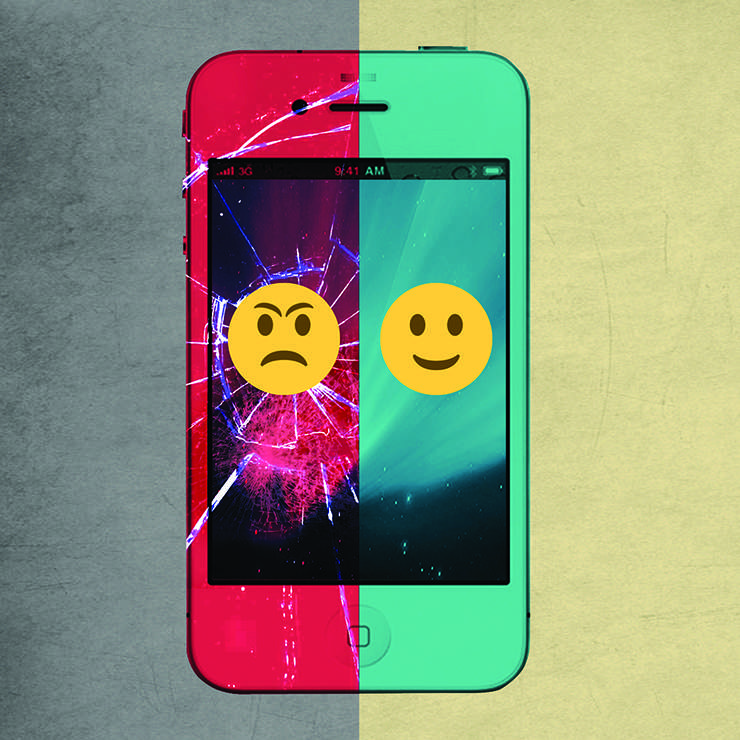As nearly 10,000 freshmen and transfers arrived on campus at the University of California, Los Angeles, last fall, they were invited to try something never before offered during student orientation: depression screening.
The hope, administrators explained, is that by identifying their risk for depression, students can get the support they need before they face the rigors of academia and the disorienting experience of living away at college. There’s reason for the concern. In 2016, a record high of almost 12% of UCLA freshman reported “frequently” feeling depressed in the past year. And a report from Penn State, drawing data from 139 university and college mental health services, found that in the 2015–2016 year, use of these services increased by 30%, although enrollment grew by just 5%. This included “a persistent increase in ‘threat-to-self’ characteristics such as nonsuicidal self-injury and suicidal ideation.”
The screening initiative—which will be extended to the entire student body eventually—is part of the UCLA Depression Grand Challenge, a landmark effort to understand one of the most pervasive and debilitating health conditions in the world, one that affects an estimated 350 million people and contributes to the suicides of 800,000 people, including 40,000 Americans, every year.
The university launched the challenge in 2015 as a multiyear, interdisciplinary study to develop better methods of understanding the genetic and environmental causes of depression and to improve detection, evaluation, and treatment. The goal is ambitious: to cut the global depression rate in half by 2030.
This comes at a time when public health officials around the world struggle to get their hands around what is considered the leading cause of disability among adults, costing some $210 billion in medical and long-term care and lost productivity hours each year.
“That depression has not been identified as our number-one health issue astounds me,” UCLA Chancellor Gene Block said in announcing the campus-screening program in September 2017.
Unpacking the blues
While mental health experts are cautious about calling depression an “epidemic”—citing better screening and greater understanding and acceptance of the condition as possible reasons for increased diagnosis—the numbers are still startling: 350 million sufferers worldwide. According to UCLA, if you haven’t experienced depression yourself, you know someone who has.
It is also now recognized as being at the core of numerous mental health conditions, from bipolar disorder (powerful swings between high and low mood) to postpartum depression, just to name a few.
Many of the symptoms of depression are familiar: persistent low mood, exhaustion, loss of appetite and sex drive, an inability to enjoy life or cope with everyday activities—like socializing or even getting out of bed. But some may not be as obvious, such as disordered and distorted thinking, agitation, physical aches and pains, and insomnia.
Yet despite how much we now know about what depression is, we still don’t really know what causes it. What we do know is that a variety of wide-ranging factors seem to influence a person’s risk of developing depression, including childhood adversity; genetic make-up; chemical changes in the brain and body; certain unhelpful styles of thinking and relating; and social, economic, and cultural deprivation.
The truth is, there are likely myriad interrelating causes involved in each case. “We’re all vulnerable in a sense because we all have factors that contribute to that vulnerability,” says Zindel Segal, a professor of psychology at the University of Toronto who specializes in depression.
Further complicating matters, depression doesn’t always act the same way from individual to individual, or from episode to episode, which can range from mild to severe. An episode can last from a few days to weeks, months, or even years.
All of these factors make treatment difficult, because each sufferer will need something different. Indeed, treatment for depression is a bit of a guessing game, with only a 50% success rate with the first intervention tried. Antidepressants work sometimes, but not always. Talk therapies help some people, but not others. Someone may feel better with increased social contact, a change in relationships, or a new job. For others, becoming less busy or starting an exercise regime is what makes the difference. Sometimes the passage of time is what helps. Unfortunately, because depression plays havoc with the capacity to see things accurately, it’s hard for a depressed person to know what they need.
Because depression plays havoc with the capacity to see things accurately, it’s hard for a depressed person to know what they need.
And while most people recover from a depressive episode, it’s a chronic, relapsing condition, with recurrence ever more likely each time it strikes. It’s commonly accepted that if you experience even one depressive episode, you have a 50% greater chance of experiencing another.
Dodging the wrecking ball
At this point you might be thinking, “Now you’re going to tell me that this is where mindfulness fits in.” After all, doesn’t the practice of paying attention to the present moment enhance our ability to see clearly, stabilize the mind, and be freed from unskillful patterns of thinking and behavior? Doesn’t it have salutary effects on the mind, brain, and body?
Well, yes. But, also, no.
Psychologists widely agree that mindfulness has an important role to play in managing the condition—as a self-care practice, and by helping us to tune in to the natural ebbs and flows of energy and mood.
In fact, having a regular mindfulness practice may help someone who struggles with depression to notice when they’re at risk, allowing them to take appropriate action, if not to avoid an episode, then to at least minimize its impact.
Having a regular mindfulness practice may help someone who struggles with depression to notice when they’re at risk, allowing them to take appropriate action, if not to avoid an episode, then to at least minimize its impact.
“I think somebody who has a mindfulness practice and a history of depression will know themselves whether they need rest, or whether it would be better to walk the dog or go to work,” says Willem Kuyken, a professor of clinical psychology at the University of Oxford, and director of the Oxford Mindfulness Centre, which has pioneered mindfulness-based treatments for depression. “What’s so beautiful and transformative about mindfulness is that it places the wisdom in the person and their own practice. They have a sense of ‘what’s happening with my mind and body at the moment?’ and how to shift from automatic pilot to more of an experiential present-moment mode. From that place they can judge what feels skillful and discerning.”
One model in particular, Mindfulness-Based Cognitive Therapy (MBCT), which offers mindfulness training in conjunction with cognitive-behavioral therapy, appears to be particularly effective. “We’ve got 10 randomized controlled trials suggesting that for people with a long history of depression, MBCT does much better than usual care,” Kuyken says.
He explains that depression makes someone more likely to react to life’s setbacks with negative, judgmental thinking, which can lower their mood and trigger a new episode. Mindfulness helps create mental space around these thoughts, enabling people at risk to observe, with kindness, the patterns of the mind that might otherwise drag them down.
He shared the example of a former client. “She was a young mother who was pushing her toddler son on a swing. It was a happy moment, but then a thought popped into her head: ‘I don’t deserve to be happy, and this happiness won’t last.’ We all have thoughts like this, but for someone who’s vulnerable to depression those shards of negative thinking can quickly spiral into a whole bunch of other negative thoughts, associated emotions, and behaviors.”
For this woman, he says, the thoughts came in the form of “I’m a rubbish mother” and the internal thrashing that typically followed. Prior to MBCT, he says, going down that path “might have led her to do a ‘duvet dive’ and hide away from the world,” resulting in more rumination and furthering the downward spiral. Instead, she was able to recognize the destructive pattern forming—what she called “wrecking-ball thoughts”— and take a sideways step, allowing the thought to pass through her mind without being knocked over by it.
Zindel Segal, one of the creators of MBCT, agrees. “Qualitative analyses show the core takeaway from MBCT is I am not my depression. That the self is bigger than that.
“That’s a source of liberation, because they can choose how they want to act, rather than running to the first solutions that the mind offers, which can often be reactive,” he adds. “Their symptoms may not reduce to zero, but their well-being and resilience increases as they develop a different relationship to them.”
There’s a time and place for mindfulness
For the great success mindfulness, and MBCT in particular, has shown for helping people with a history of depression to avoid or lessen the impact of those depressive dips, there are equally strong caveats against using the practice when you’re in the throes of an episode.
“It’s very hard to sit and do formal meditation practices when you’re depressed,” Segal says. “The executive control networks of the brain are often compromised when you’re in an episode of depression, and it’s di cult to engage.” In other words, when the world goes dim and life feels bleak, your brain might not have the bandwidth to be a kind, nonjudgmental observer to its own thoughts, or to grasp the bigger picture.
Susan Woods, a psychotherapist and mindfulness teacher in Vermont, goes further: “If somebody is in a major depression episode, mindfulness is useless. There’s just no energy there, no ability to concentrate for any length of time.”
Even if a person with depression is able to engage with meditation, there is a risk that heightened exposure to the unpleasant symptoms of their illness, experienced while paying mindful attention, could actually increase their fear and aversion, triggering a reactive spiral of deepening low mood. “There is some evidence that vulnerable people exposed to mindfulness can have quite unsettling experiences,” says Kuyken. “That makes complete sense,” he says, because when people are depressed, the mind “can be quite dark and scary.”
Also, if depression seems more to do with a person’s life situation, rather than their inner patterns of thinking, feeling, and relating, they may need assertive action more urgently than meditation. “If someone is in circumstances of tremendous adversity or abuse, they first need to get to a place that’s safe,” adds Segal. “If your house is on fire, you need to get out.”
A mindful exception
There are exceptions to every rule, of course. I learned to meditate toward the end of a two-and- a-half year major depressive episode, and it was the key that released me from a prison of constantly fighting my inner demons, a pattern that kept them running rampant. However, by the time I started practicing, I had already undergone intensive psychotherapy, begun to make much-needed lifestyle shifts, and understood some of the ingrained mental and behavioral habits that were maintaining my low mood. Meditation was a vital piece of the puzzle—a practical skill that helped me discover the art of letting go—but I also remember how tough it was the first times I tried to sit and focus on my breath. It felt like I was going to explode from the intensity of the sensations inside me. It took a lot of commitment, a lot of support, and a lot of going gently for the practice to bear fruit. In the earlier phases of my illness, I doubt it would have helped so much.
A few small-scale studies suggest MBCT can help people in the midst of an episode, but Segal notes the quality of evidence is low, and Woods points to the fact that the courses in these trials were often led by very experienced teachers, who were also specialists in treating depression. Kuyken shares their concerns: “With vulnerable clients, teachers need to be well-trained and very skilled in how they teach mindfulness.”
Because it’s so difficult for the depressed mind to discern what it needs, the best first step to wellness is professional support. A competent therapist can act as a guide to skillful action, helping you form a treatment plan. This, according to Woods, is likely to include antidepressant medication, slowly building in self-care activities that can help stabilize and elevate mood, and cognitive therapy to help you understand and work with your individual triggers. There is mindfulness here, but it comes from the therapist as a wise, compassionate friend—much needed when you can’t locate your own inner compass.
Once mood has stabilized, mindfulness training can be part of the plan. At this point, says Segal, a mindfulness-trained therapist might recommend a mindful movement practice. Woods suggests short sitting practices, such as the three-minute breathing space (at right), to be practiced several times a day and at the beginning of a therapy session. After a few months of stability, it might be time to enroll in a group-training program, such as MBCT.
Moving forward
So, when depression is present, it probably isn’t the time to engage in meditation. However, there’s cautious optimism that when mindfulness is developed and practiced while a person is feeling emotionally stable, it may increase their ability to navigate difficult situations or emotional upheavals in the future. In this sense, it may be a powerful buffer against the ups and downs inevitable in every life.
When mindfulness is developed and practiced while a person is feeling emotionally stable, it may increase their ability to navigate difficult situations or emotional upheavals in the future.
By showing people sad movie clips during an fMRI scan, Segal and his colleagues in Toronto found that mindfulness practitioners’ brains showed more activation in sensory processing regions, such as the insula and somatosensory cortex, but less activation in midline prefrontal structures, which are associated with the mental rumination that is often problematic for people with depression. This indicates that while mindfulness-trained people feel their emotions intensely, they are less likely to think that sadness is a problem to x, a cognitive stance that can lead to depression. Also, a key element of mindfulness may be a shift to enhanced sensory experience and a corresponding decrease in “living in your head.”
Evidence also shows that practicing mindfulness can start an upward spiral of mood and behavior, enabling people to become more fully integrated in their lives, and bringing with it a greater sense of freedom and flourishing. “In the longer term, sustained practice is a profound generator of compassion and connectivity,” explains Segal, “and that starts to change how people interact with one another. It’s at a much broader scale than people just looking to deal with their mind disorder, although that is an important starting point.”
This potential for wider social impact hasn’t escaped the notice of politicians: A 2015 report by the United Kingdom’s Mindfulness All-Party Parliamentary Group recommended that MBCT be made more available in the country’s National Health Service, and a global group of policy-makers—including US Congressman Tim Ryan—has formed to explore the possibilities further. Meanwhile, the Oxford Mindfulness Centre has begun a seven-year program of research into teaching mindfulness in schools to see if it can help students’ resilience as they enter the teenage years, a common age for the rst appearance of mental health problems. “Can we take 11- to 14-year-olds,” asks Kuyken, who’s leading the project, “and teach them the skills to prevent depression from ever occurring?”
Preventing depression among those at risk is where more mindfulness training could be, as Segal says, “a public health win.”
“It would have a huge impact on the health landscape, because people wouldn’t be coming back into treatment, and they’d be more effective in parenting, as partners, and at work,” he explains. “They could enroll in all sorts of activities that would have much-needed effects in areas of wellness aside from mental health.”
Getting Help
If you experience depressive episodes, you’ll need to pay close attention to the types and doses of mindfulness practice you use and consider seeking the aid and advice of a therapist or psychiatrist who can assess your unique needs. Mindfulness-Based Cognitive Therapy (MBCT) has developed practices that have proved effective for some people with depression; however, mindfulness practice is not recommended during depressive episodes. If your depression is deeply interfering with your ability to live your life, it is best to consult a professional.
First steps to take when you’re depressed
When a depressive episode strikes, we need a personalized action plan to help stabilize and elevate mood. Here are some ways you might start taking care of yourself.
- Seek help. “Recognize that you’re dealing with a legitimate condition that requires care,” says Zindel Segal. “Many people see depression as a personal inadequacy, which is actually one of its symptoms.” See your doctor and ask for treatment. You may be prescribed antidepressant medication and/or referred to a therapist, who can help create a treatment plan tailored to you and your circumstances.
- Do something pleasurable every morning. “This might be something like taking a long warm shower or bath, or getting up and making that first cup of coffee or tea,” says Susan Woods. “Mornings can be really difficult when you’re depressed, so make sure that you get out of bed and do something that usually gives you pleasure.” Do something each day that brings a sense of accomplishment “Washing the dishes, doing the grocery run—these kinds of activities can really help give a sense of accomplishment,” explains Woods. “Just do one of them rather than making a whole list.”
- See a friend at least twice a week. “Social isolation can happen quickly,” says Woods, “so reaching out to a dear friend and making an appointment to see them can bridge that.” Get some fresh air “Going for a walk, especially in nature, can be helpful,” says Segal, “because it can pull people out of rumination.” Exercise has been shown to have antidepressant properties; some therapists even go on walks with their patients rather than sitting in the consulting room.
3-Minute Breathing Space
This short practice is taught and repeated throughout Mindfulness-Based Cognitive Therapy. It’s intended to help bring formal mindfulness practice into moments of everyday life. It’s considered the most important practice in the program.
Begin by deliberately adopting an erect and dignified posture, whether you are sitting or standing. If possible, close your eyes. Then take about one minute to guide yourself through each of the following three steps:
- Becoming aware. Bringing your awareness to your inner experience, ask: What is my experience right now? What thoughts are going through your mind? As best you can, acknowledge thoughts as mental events, perhaps putting them into words. What feelings are here? Turn toward any sense of emotional discomfort or unpleasant feelings, acknowledging their presence. What body sensations are here right now? Perhaps quickly scan your body to pick up any sensations of tight- ness or bracing.
- Gathering. Now, redirect your attention to focus on the physical sensations of the breath. Move in close to the sense of the breath in the abdomen, feeling the sensations of the abdominal wall expanding as the breath comes in and falling back as the breath goes out. Follow the breath all the way in and all the way out, using the breathing to anchor yourself in the present. If the mind wanders away at any time, gently escort it back to the breath.
- Expanding. Now, expand the eld of your awareness around your breath- ing so it includes a sense of the body as a whole, your posture, and facial expression. If you become aware of any sensations of discomfort, tension, or resistance, take your awareness there by breathing into them on the in-breath. Then breathe out from those sensations, softening and opening with the out-breath. As best you can, bring this expanded awareness to the next moments of your day.
This article appeared in the February 2018 issue of Mindful magazine.
Mindfulness-Based Cognitive Therapy May Reduce Recurrent Depression Risk
The post When the Mind Goes Dark appeared first on Mindful.
from RSSMix.com Mix ID 8196908 https://www.mindful.org/mind-goes-dark/




